Use Analysis Analysis
Analysis  Optimization in the FEA Editor or Results environment to access the Design Optimization dialog. The Parameters tab is used to specify the solution parameters for the Design Optimization only; the values on this tab have no affect on a Design Study.
Optimization in the FEA Editor or Results environment to access the Design Optimization dialog. The Parameters tab is used to specify the solution parameters for the Design Optimization only; the values on this tab have no affect on a Design Study.
The Optimization Method sets the algorithm to use for the design optimization. The choices are as follows:
- SLP: Uses a Sequential Linear Programming method to solve the analysis. First, a Taylor series approximation (linear) of the objective and constraint functions is created. This approximation is used to find the optimum solution. This method is the most reliable solution method.
- SQP: Uses a Sequential Quadratic Programming method to solve the analysis. First, a Taylor series approximation (quadratic) of the objective functions is created. A linear approximation of the constraint functions is created. These approximations are used to find the optimum solution. This method is faster than the SLP, but it is not always as stable.
- Response Surface: Creates a global function that represents the response of the model to the changing design variables. Since the function covers a larger span, the function is not as detailed as either the SLP or SQP methods. Thus, the optimized value found by using the Response Surface method may only be an approximation of the actual optimized value. For a more accurate solution, run the Response Surface to get close to the optimized value. Then use either the SLP or SQP methods with input based on the response surface results.
Be aware that the absolute optimum solution is guaranteed only if the objective is convex (when finding the minimum) or concave (when finding the maximum) within the design range from the lower limit to upper limit of each design variable. If the optimization curve has inflections, then a local optimum result may be found; using a different optimization method or adjusting the upper and lower limits may find a different optimum result. See Figure 1 for an illustrated example.
Objective/Constraints
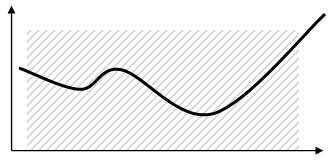 Design Variables
Design Variables
Design Range
(a) The theoretical curve of the objective/constraint equation. The minimum is obvious if the curve is known, but it is not known ahead of time. Numerical methods calculate the curve and try to locate the minimum with the least computational effort.
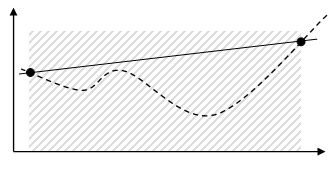
(b) With the SLP method, the curve is evaluated at the upper and lower limit of the design range. Since the lower limit is the minimum, the line search begins at the lower limit.
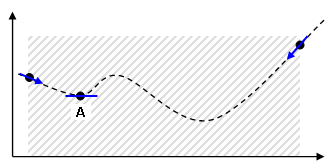
(c) Using various parameters, the search routine finds a minimum at point A on the theoretical curve. Once a minimum is located, the solution has converged. It is not the absolute minimum but a local minimum.
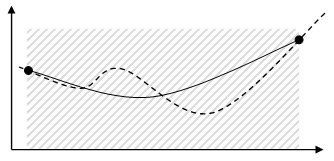
(d) With the SQP method, a quadratic equation is used to estimate the theoretical curve.
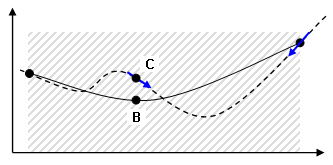
(e) The minimum of the quadratic equation occurs at B. At this value of the design variables, the theoretical curve is at C and has a calculated slope.
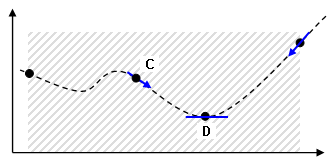
(f) The search routine uses various parameters to find a minimum point D on the theoretical curve. Once a minimum is located, the solution has converged.
Figure 1: Illustrative Example of Finding the Minimum
A few other notes regarding Figure 1 should be stated.
- The search direction and move limits are more affected by the upper and lower limits when using the SLP method than when using the SQP method.
- The constraints (upper and lower limits on the stress, deflection, and so on) are not guaranteed to be satisfied at the optimum value found by the above methods. Once the point of 0 slope is located (the optimum), there is no way for the routine to decide where to move to if a constraint is violated. In such situations, the range of the violated design variable can be adjusted, and the optimization analysis repeated.
The Maximum Iteration field indicates the number of iterations to use during the optimization. If the solution is not found within this number of iterations, then the design optimization stops. Always check the log file after the analysis completes to see how close the constraints came to the specified limit.
Keep in mind that the complete optimization analysis could run the analysis several times the maximum number of iterations specified. If a normal analysis requires half an hour and you specify 20 iterations, then the total optimization could require a minimum of 10 hours to complete and possibly as many as 60 to 100 hours to complete (depending on the number of design variables and how many iterations are required to converge).
The Maximum Objective Change field determines when the solution has converged to the answer. It is a tolerance. If the change in each constraint value (an objective/constraint specified on the Performance tab) from one iteration to the next iteration is within the range of the current result times the tolerance, then the solution has converged. (Stated mathematically, -tolerance <= (current result - previous result)/current result <= +tolerance.)